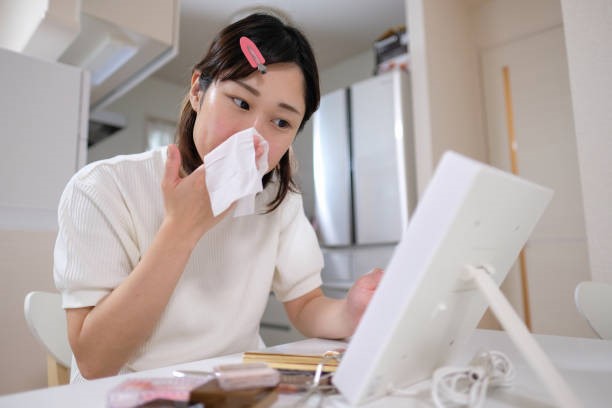
Mold can cause a lot of damage to your home and health, but the key is recognizing early signs of mold so you can take steps before it becomes a major problem. As a certified mold inspector and specialist, I want to share some tips on how you can identify early signs of mold in your home.
The first thing you should look for when examining potential mold growth are water stains, discoloration or changes in texture of walls and ceilings. These could be caused from water leakage due to plumbing issues or roof problems that have gone unnoticed. If there’s been any kind of flooding recently, this will also increase the risk for mold damage. Also inspect around windows and doors where condensation may occur since this creates an ideal environment for fungal growth.
Finally, you need to pay attention to any musty odors in your home as they could indicate the presence of hidden mold colonies growing behind drywall or under floorboards. Don’t ignore these warning signs — if something doesn’t seem right, investigate further and get help from a professional if necessary! In my next article I’ll explain more about what to do once you’ve identified possible mold damage so stay tuned!
Definition Of Mold Damage
Mold damage is a pesky problem, familiar to many. It’s the bane of homeowners; it’s an eyesore for landlords; and it can cause a world of hurt if left unchecked. But what exactly is mold damage? Is your home at risk? Let’s take a look!
At its core, mold damage refers to any kind of destruction or degradation caused by fungi in moist environments. These fungi have the potential to not only ruin surfaces but also release harmful toxins into living spaces – making them unsafe to inhabit. Fortunately, there are steps you can take to identify signs of mold growth early on so that you don’t suffer the consequences down the line.
The key is knowing where to look: common areas such as basements and attics are especially vulnerable due to their dampness and condensation levels. By keeping tabs on these spots and being proactive about maintenance, you’ll be well-equipped with the knowledge necessary for protecting yourself from mold damage – now let’s move onto exploring those common areas of growth!
Common Areas Of Growth
Mold is a naturally occurring organism, and it can grow anywhere in your home. Unfortunately, there are some places that mold loves to grow more than others. It’s important to recognize these common areas of growth so you can take the necessary steps to prevent the spread of infestation.
Here are five key areas where mold tends to thrive:
– Wet basements or crawl spaces
– Bathrooms with inadequate ventilation
– Areas around windows and doors with poor insulation
– Behind walls and ceilings that have been exposed to water damage
– In poorly ventilated attics or other dark, damp spots
By understanding where mold likes to live and recognizing the early warning signs of an infestation, you can proactively protect your family from further health risks associated with prolonged exposure. Keep an eye out for any visual symptoms of infestation so you can act quickly if needed.
Visual Symptoms Of Infestation
It is important to be aware of the visual symptoms that can indicate an infestation. Mold damage often presents itself in various colors, shapes and sizes which can vary greatly from one area of growth to another. It may appear as fuzzy or slimy multi-colored patches on walls, floors, furniture and other surfaces. In some cases it may even present itself as a black discoloration. If you see any of these signs in your home, then there is a good chance that mold has already taken hold.
In addition to visible signs, water damage should also be considered when assessing for mold contamination. Any stains appearing on ceilings, walls or floors could be indicative of past or current flooding issues which are ideal conditions for mold growth. Furthermore, if you notice any areas where paint is bubbling or peeling this could point towards moisture seeping through into structural components such as drywall or wooden beams underneath the surface.
Finally, it’s not just visual clues that require attention – unusual smells can sometimes provide further evidence of active fungal colonies within a property. Unpleasant odors emanating from wall cavities and other hidden spaces might suggest elevated levels of humidity trapped inside resulting in rampant microbial activity below the surface level.
Unpleasant Odors
Mold growth can produce odors that are unpleasant and musty. These smells can be a sign of possible mold damage, so they should not be ignored. It is important to note that the smell alone does not necessarily mean there is an active fungal infestation; it could just indicate previous water or moisture damage with no current activity present.
|Signs |Evidence |
|—–|——–|
|Smells |Musty odor|
| |Unpleasant odor|
| |Chemical-like smell (e.g., bleach)|
A chemical-like smell may also exist if someone has attempted to clean the area themselves using bleach, vinegar, ect. In these cases, visual inspection of the affected areas will be necessary to determine whether or not actual mold growth is happening in addition to any cleaning efforts taken by the homeowner.
In some situations, higher concentrations of airborne spores can create a noticeable ‘dust cloud’ when disturbed inside an enclosed space such as a closet or attic. If this occurs and there are other signs mentioned above present, then further investigation into potential mold growth should be conducted without delay.
Often times people will experience allergy-like symptoms which could indicate the presence of mold even before any visible evidence appears or odors become obvious. Therefore, it’s important for homeowners to pay close attention to changes in their environment and take action quickly if something seems amiss.
Allergy-Like Symptoms
It’s estimated that around 50 million Americans suffer from allergies. Mold is a major cause of these allergic reactions and can create health problems if not properly addressed. Symptoms include sneezing, coughing, wheezing, itchy eyes, runny nose, shortness of breath and chest tightness. Additional symptoms may include headaches, fatigue, skin rashes and more severe respiratory issues such as asthma attacks. If you experience any of the above signs or notice an increase in allergy-like symptoms near your home or business it could be indicative of mold growth on the property.
Inspection for active mold colonies should be conducted immediately to identify potential problem areas before they worsen. A certified mold inspector will use specialized equipment such as infrared cameras to detect hidden moisture sources behind walls, floors and ceilings which are prime locations for mold development. Samples can also be taken from areas where visual inspection indicates microbial activity and sent to a laboratory for further analysis. Following this assessment, preventive measures can then be implemented to reduce allergen levels so that occupants do not suffer from long-term adverse health effects due to prolonged exposure.
By recognizing early warning signs of mold damage like those mentioned above one can take action quickly to ensure the safety and well being of their family or employees by having an experienced specialist perform a comprehensive evaluation with appropriate testing procedures when necessary. This way possible contamination can be identified promptly allowing remediation activities to begin right away thereby minimizing potential risks associated with airborne fungi spores present in indoor spaces.
Health Risks Of Exposure
Mold can have a severe impact on human health, especially when it’s left unchecked. Inhaling spores or coming into direct contact with mold-contaminated materials can result in respiratory issues such as asthma and allergies. It can also cause skin irritation, headaches, sinus congestion, eye irritation, throat irritation and fatigue. These symptoms may appear immediately or take some time to develop depending on the person’s sensitivity level and the degree of contamination.
It is important for people to be aware that these health risks exist so that if any of those signs are present they should seek medical advice right away. If you’re worried about possible exposure to mold in your home, workplace or school environment it’s best to consult a certified mold inspector who will provide an assessment report outlining potential sources of infestation and offer recommendations regarding remediation measures.
The earlier you recognize the presence of moisture leading to mold growth – which could include water stains from roof leaks, damp basements or crawl spaces – the sooner you can start taking corrective action to prevent further damage and protect yourself against ill health effects associated with mold exposure.
Identifying The Source Of Infestation
It is important to be able to recognize the early signs of mold damage in order to take preventive action. According to a recent study, roughly 70% of all indoor air pollution is caused by microbial contaminants such as molds and fungi. As a professional certified mold inspector, I recommend that anyone who suspects their home has been affected by mold should be aware of what to look for.
The first sign that may indicate an infestation can be found on walls or ceilings where discolored spots are present. Other possible indicators include water leaks, musty odors, or visible growths behind furniture or inside closets. If any of these signs are observed, it’s best to contact a licensed specialist immediately in order to assess the situation and determine the source of infestation before taking further steps towards remediation.
No matter how small or insignificant an area may seem, if there are any concerns about potential mold growth it’s always better to investigate further rather than neglecting the issue. Early detection could save time and money down the road since more extensive repairs may become necessary depending on the type and extent of contamination uncovered during inspection process. Moving forward into diy solutions for removing mold requires knowledge and skill so make sure you’re armed with everything needed beforehand in order to ensure success.
Diy Solutions For Removing Mold
When it comes to mold damage, DIY solutions can be a great starting point. However, if the problem is widespread or severe, professional services may be required. It’s important to understand the risk of attempting removal without proper equipment and training.
If you choose to take on the task yourself, begin by containing the area where possible with plastic sheeting. This will help stop spores from spreading further into your home or business. Next, use an EPA-registered antimicrobial cleaning solution designed specifically for removing mold contamination. Make sure to follow the label instructions carefully when using this type of product. Wear protective gear such as gloves and face masks while applying these solutions in order to avoid direct contact with any potentially hazardous materials in the air. Lastly, thoroughly dry out affected areas after cleaning up existing mold growth. High humidity levels are often conducive for future growth so make sure all surfaces have been completely dried before closing off contaminated rooms or spaces.
Inadequate containment and poor cleanup procedures can lead to significant health risks from toxic airborne particles released during remediation efforts; therefore professional assistance should always be consulted when dealing with large scale infestations of mold damage.
Professional Services For Mold Removal
Now that the DIY solutions for removing mold have been discussed, it’s time to consider professional services for mold removal. Even if you’re able to remove surface mold on your own, there may be deeper issues that need expert attention. Mold damage can cause significant health risks and structural damage over time, so recognizing early signs of this type of damage is important.
Here are some telltale signs a certified mold inspector will look for:
– Musty odors in the home or office space
– Visible growths on walls, floors, ceilings, pipes, furniture and other surfaces
– Discoloration or staining (black spots) on walls and/or ceilings
– Water stains or bubbles along baseboards or windowsills
– Warped wood flooring or warping around window frames
It’s important to note that because mold needs moisture to grow and thrive, any areas with water leaks should also be inspected closely since these could indicate the presence of an underlying problem. A certified mold inspector is trained to identify potential sources of moisture as well as current levels of infestation within the building. Professional remediation services can help assess existing problems safely and effectively with minimal disruption to your daily activities.
By catching possible warning signs before they become too severe, homeowners and business owners alike can save money from costly repairs down the line — something every one should strive for! Transitioning into preventative measures now might just save everyone both time and resources later.
Preventative Measures To Avoid Future Infestations
Preventative measures are essential for avoiding future mold infestations. The key is to reduce the moisture levels in your home or office as much as possible and identify any water damage that may be present. It’s important to inspect areas of high humidity, such as basements and bathrooms, on a regular basis for signs of condensation. If you find standing water anywhere in your property, it should be cleaned up immediately. Additionally, ensure proper ventilation by regularly opening windows when necessary and running fans whenever possible to reduce accumulated moisture in enclosed spaces.
To further protect against mold growth, use mildew-resistant paint on walls subject to mold infiltration, repair any leaks promptly and install dehumidifiers if needed. You can also seal cracks around door frames and window sills with caulk or expanding foam insulation to prevent moisture from entering inside the building. Finally, make sure all surfaces are kept dry at all times using absorbent materials like towels near faucets where water overflow may occur; this way you can catch any potential seepage before mold has time to form.
By taking these steps now, you will have taken proactive measures towards preventing costly problems due to mold down the road. Implementing these strategies right away will help keep your home environment safe and healthy in the long run.






